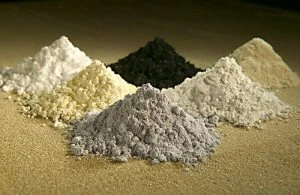EVs and Rare Earth Mining

Rare earth metals.
Where are all the earth’s rare metals mined? Are electric vehicles (EVs) really so environmentally sound and friendly?
Rare earths are difficult to find and obtain in most parts of the world, and they are used a lot in all sorts of common and accessible products like mobile phones, cars, aeroplanes, missiles, radars etc. Rare earths are also abundantly used in EVs. EVs use special magnets to power their engines, and most of the magnets in EVs that can cover longer distances on one battery charge are made from rare earth metals. The metals aren’t necessarily rare, but they can be dirty and difficult to process. Many of the processes related to rare earth extraction (getting the rare earths out of the ground) are dangerous, environmentally unfriendly, and, in many cases, the mining workers are older boys and younger men. The process to obtain many of the rare earths is environmentally destructive and produces radioactive waste.
Of the 17 rare earths, neodymium is possibly the most needed rare earth in the world right now. EVs cannot function without neodymium, and lithium – which is currently mostly found in Bolivia.
China has a large portion of the rare earth mining pie and supply network. Back in 2010, China produced as much as 90% of the rare earths that the world needed, and it now seems obvious to me why China’s economy and infrastructure was booming so much at the time. Also, around this time, the rest of the world started to see just how China ruled the rare earth market and power struggles commenced.
Without the rare earth metal, neodymium, an iPhone cannot vibrate and wind turbines would not work. In order for EVs to gain more milage between charges, Rare Earth Permanent Magnets (REPM), which use neodymium, are required. REPMs are the most powerful magnets currently available.
So, though rare-earth elements are used in trace amounts, their unique properties, which include magnetic, heat-resistant, and phosphorescent qualities, make them essential in the production of products like batteries, car engines, EVs and LCD TV displays. EV motors, iPhones, military jet engines, batteries, and even satellites all have something in common: They require rare-earth elements to function.
Other elements like terbium, tritium and europium are crucial to targeting mechanisms in all high-tech weaponry systems. The higher-tech that an EV becomes, a corresponding increase in the level of rare earth mining will be required. The more EVs that are run on the roads (resulting from strict emission standards and government taxing), the more the rare earth resources will be called upon to build and maintain the EV fleet. Currently, an EV battery doesn’t last much longer than 10 years, so EV battery replacement requirements will mean that much more rare earth metals will be needed to maintain the ever-growing global EV fleet.
As of 2018, China had 37% of the world’s rare earth deposits. Brazil currently has 22%, Vietnam 18%, Russia 10% and India has 5.8%. The rest of the world, including the US and Japan, have the rest.
Despite having more rare earth ore than the US, India only mined 3,000 tonnes of rare earths in 2020. During 2020, the US mined 38,000 tonnes. Meanwhile, Australia mined 17,000 tonnes and China mined 140,000 tonnes. In 2020, the US had 16% of the production rate of the world’s rare earths; Australia had 7%, and India had 1%.
In 2020, the following countries were the biggest producers of rare earth metals:
China, mine production: 140,000 MT
United States, mine production: 38,000 MT. The US is also a major importer of rare earth materials, with their demand for compounds and metals worth US$110 million in 2020. The US has classified rare earths as critical minerals, and it is a distinction that has come about from recent trade issues between the US and China.
Myanmar (also known as Burma), mine production: 30,000 MT. Myanmar mined 30,000 MT of rare earths in 2020, up from 22,000 MT the previous year. Myanmar provided 50% of China’s medium to heavy rare earths feedstock.
Australia, mine production: 17,000 MT. Australia holds the sixth largest-known rare earths reserves in the world. It is poised to increase its output, where the production of neodymium-praseodymium products is projected to increase to 10,500 tonnes per year by 2025. Northern Minerals opened Australia’s first heavy rare earths mine in 2018. Its main products are terbium and dysprosium, the latter of which is used in technology for things like permanent magnets.
Madagascar, mine production: 8,000 MT.
India, mine production: 3,000 MT. India holds almost 35% of the world’s total beach sand mineral deposits.
Russia, mine production: 2,700 MT. Russia intends to increase the nation’s share of global rare earths production from the current 1.3% level to 10% by 2030.
Thailand, mine production: 2,000 MT.
Vietnam, mine production: 1,000 MT.
Brazil, mine production: 1,000 MT.
Rare-earths are also mined in South Africa, Canada, Estonia, and Malaysia.
Is an internal combustion engine’s resultant emissions and fossil fuel use really worse than the rare earth metal production mining for EVs and other high-tech electronics? I would question whether a modern and new internal combustion engine with its catalytic converter to capture any emissions is worse than an EV’s definite connection to negative environmental impact and questionable work-force ethics.
Sometimes it is easier to disregard these pre-showroom EV facts and talk about the post-showroom EVs being so wonderful and environmentally-friendly with their so-called zero emissions. Perhaps hydrogen-fuelled cars (to a certain extent), solar energy, and, definitely, cars running on biofuels are a sounder transport investment, but I guess money, power and business links still talk louder for some.